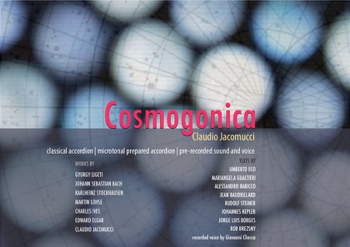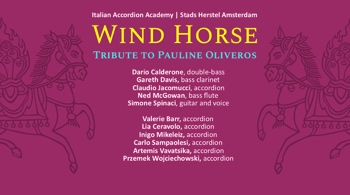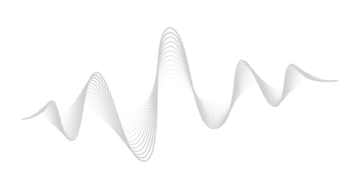Claudio Jacomucci’s compositions
Incantesimi (2023) for doublebass, accordion, electric guitar, bass clarinet (25')
Le Città Invisibili (2021) for microtonal prepared accordion and quadraphonic system (40')
WP: Amsterdam, NieuweNoten Festival. Claudio Jacomucci
Ballata per Lupo (2018) for accordion solo (12’)
WP: Lyon, Villeurbanne Conservatory. Claudio Jacomucci
Tiamat (2017) for microtonal and prepared accordion (8’)
WP: Istituto Italiano di Cultura in Bruxelles. June 21th, 2017.
Claudio Jacomucci
Co-incidences (2015) for 5 accordions (8’)
WP: Splendor, Amsterdam - May 20th, 2015.
The Musicians of the Italian Accordion Academy: Andrzej Grzybowski, Luca Pignata, Alessandro Ambrosi, Wieslaw Ochwat, Claudio Jacomucci.
In G - Tribute to Gino Pigini (2014) for a huge accordion ensemble
WP: Pigini Accordion Factory, Castelfidardo, 100th Anniversary of Gino Pigini’s birth, premiered with Kathleen Delaney,
professional and amateur accordionists, students, craftsmen, workers, distributors and managers of Pigini Accordions.
Fraternità solare, for/with Mariangela Gualtieri (2014) for accordion ensemble and reciting voice (30’).
Poems by Mariangela Gualtieri
WP: Il Fiore delle Mille e una nota 3, Urbino, Teatro Sanzio, 2014 (with Mariangela Gualtieri and The Musicians of the Accordion Academy)
Suite Vénitienne/Follow me (2014) for doublebass, accordion, 2 dancers, text (30’)
Music by Daniele Roccato and Claudio Jacomucci
Choreography by Kathleen Delaney
Text by Sophie Calle
WP: Il Fiore delle Mille e una nota 3, Urbino, Teatro Sanzio, 2014 (with Daniele Roccato, Kathleen Delaney, Roberto Lori)
Vortex (2014) for 3 accordions (‘7)
WP: Ortopolis Pesaro, Chiesa della SS. Maddalena, 2014
with Fabio Palma, Andrzej Grzybowski, Przemek Wojciechowski
Arcana (2013) for choir and accordion ensemble (12’)
WP: Il Fiore delle Mille e una nota 2, Urbania, Barco Ducale, 2013 (with Coro Polifonico Durantino, cond. Simone Spinaci and The Musicians of the Accordion Academy)
Tensegrity (2012) for 8 accordions and 4 dancers
Choreography by Kathleen Delaney
WP: Il Fiore delle Mille e una nota, Amsterdam, Vondelkerk, 2012
Aracne - The Rite of Tarantula (2010) for accordion, dancer, electronics, video (28')
Choreography by Kathleen Delaney
Original film by Gianfranco Mingazzi
WP: Monastier di Treviso, Festival Anima nella Fisarmonica (2010)
Cool Memories - Hommage a Jean Baudrillard (2008) for accordion, dancer, electronics, video text (30')
Video 2
Choreography by Kathleen Delaney
Text by Jean Baudrillard
WP: Helsinki, STOA Theatre (2008)
Au-delà de la fin (2007) for dancer, accordion, video, animated text, lights (24')
Choreography by Kathleen Delaney
Text by Jean Baudrillard
WP: Bourges, Synthese Festival Imeb 2007
Infernal Circles: Eurydice in the Earth (2005-2008) for accordion and electroacoustic support (16')
Choreography by Kathleen Delaney
WP: Orvieto, Pozzo di San Patrizio, Festival Venti Ascensionali (with Kathleen Delaney, dancer)
Wonderlands (2005) for accordion solo (14')
WP: Moscow, Gnessin Academy, Festival Bayan and Bayanistes 2005
Egos (2004) for accordion, dancer and electroacoustic support (20')
Choreography and text by Kathleen Delaney
WP: Pesaro, HangartFest 2004 choreography by Kathleen Delaney

ACUSMATICARMONICA (2023)
Claudio Jacomucci, microtonal/prepared accordion
Claudio F. Baroni, loop station , audio consoles
Claudio Jacomucci
Le Città Invisibili
for microtonal prepared accordion and quadraphonic audio system (2021)
https://claudiojacomucci.bandcamp.com/album/le-citt-invisibili
[33’]
Alvin Lucier
Music for accordion
with slow sweep pure wave oscillators
[10’]
Claudio F. Baroni
Vis Insita - SoLo XI
for accordion and loop station (2023)
[25']
ARTE DELLA FUGA (2020)
Claudio Jacomucci, classical accordion, prerecorded tracks
Works by Bach, Webern, Ligeti, Nancarrow, Jacomucci
[65']
Canons, fugues, ricercare, palindrome and mirroring forms, labyrinths, pendulums and other contrapuntal inventions from Johann Sebastian Bach’s Art of Fugue, Musical Offering, Goldberg Variations, and by XX Century and contemporary composers.
COSMOGONICA (2017)
Claudio Jacomucci, accordion, samples, voice, prerecorded tracks
Works by Ligeti, Bach, Stockhause, Lohse, Ives, Elgar, Jacomucci
Texts by Eco, Baudrillard, Gualtieri, Baricco, Steiner, Kepler, Borges
[60']
Both in cosmogonic myths and in traditional cosmology, we speak of sound and music.
According to Pythagoras, theorizing the principle of the music of the spheres, the Sun, the Moon and the planets of the solar system, as a result of their rotation and revolution movements, would produce a continuous, imperceptible sound from the human ear and all together would produce harmony.
"The universe sings and man is a note of the immense cosmic symphony; the one who thinks in music can access the highest peaks of spiritual consciousness. It is no coincidence for Hinduism that the original sound is similar to Om's root mantra (resumed by Christianity in Amen and Islam in Ammin). Plato described astronomy and music as twin studies for sensory perceptions. For Kepler, the music of the spheres is the medium that connects geometry, cosmology, astrology, and music. NASA has even recently recorded interstellar space sound.
This concert is a journey into the music and thought of composers, poets, scientists and philosophers of different ages that somehow reconnect to astronomy; a kind of Voyager Golden Record with a program ranging from The Unswered Question by Ives to the unfinished counterpoint of J.S.Bach's The Art of the Fugue, from the Zodiac constellations of Stockhausen to the Enigma of Elgar, from Ligeti’s Coulée of sound to Lohse’s polyrthms , passing through a series of original compositions by Jacomucci for his "pneumatic machine", a sophisticated and rare accordion of which he explores the potential to extreme limits, in sonority, technique, and even inintonation, using his own prototype of microtonal accordion, tuned to quarter-tones and prepared.
The use of pre-recorded sounds (almost always concrete and natural) creates the depth of acoustic space while the suggestive texts by Umberto Eco, Mariangela Gualtieri, Jorge Luis Borges, Alessandro Baricco, Johannes Kepler, Jean Baudrillard, Rudolf Steiner and Rob Brezsny they are a reflective counterpoint to music; as Eco writes: "After all, we seek, in our lifetime, an original story that tells us why we were born and lived. Sometimes we search for a cosmic story, the story of the universe, sometimes our personal story. Sometimes we hope to make our personal story coincide with that of the universe. "

WIND HORSE - Tribute to Pauline Oliveros (2021)
Claudio Jacomucci (accordion), Simone Spinaci (guitar), Dario Calderone (doublebass), Gareth Davis (bass clarinet), Ned McGowan (bass flute), The Musicians of the Italian Accordion Academy
Works by Pauline Oliveros, Claudio Jacomucci, Tommaso Settimi, Ned McGowan, Dario Calderone, Simone Spinaci
[75']
Pauline Oliveros’ Wind Horse, is an open score that looks like a mandala, a geometric configuration of symbols. In various spiritual traditions, mandalas may be employed for focusing attention of practitioners and adepts, as a spiritual guidance tool, as much as in this music piece the mandala constantly reminds the musicians of focusing on several options while improvising.
Drawing an invisible thread between rational and organic, softness and loudness, pitch and sound, Oliveros seeks for an instant composition characterised by an idealistic balance.
A sort of tuning of the left and right hemispheres of the brain, into the act of improvising.
In central position, “Listen”, a statement that contains void, emptiness and the fullest sound potential at the same time, that asks for action and inhibition at the same time.


INCANTESIMI (2023)
Claudio Jacomucci, classical accordion and microtonal/prepared accordion
Dario Calderone, 5 strings doublebass
Simone Spinaci, electric guitar
Gareth Davis, bass clarinet
Claudio Jacomucci
Incantesimi
for accordion, electric guitar, doublebass and bass clarinet (2023)
[25’]
Francesca Verunelli
In bianco e nero
for 5 strings doublebass, accordion and electronics (2022)
https://www.francescaverunelli.com/in-bianco-e-nero
[16’]
Claudio Jacomucci
Le Città Invisibili
for microtonal prepared accordion and quadraphonic audio system (2021)
https://claudiojacomucci.bandcamp.com/album/le-citt-invisibili
[33’]
Charm is from carmen, song, and the primary associations of charm are with music, sound and rhythm. The native word for charm is “spell”, which is related, if somewhat indirectly, to the other meaning of spell in the sense of reading letter by letter, or sound by sound. Riddle is from the same root as read: in fact “read a riddle” was once practically a verb with a cognate object, like “tell a tale” or “sing a song”. And just as the connections of charm are closer to music, so the riddle has pictorial affinities, related to ciphers, acrostics, rebuses, concrete and shape poetry, and everything that emphasises the visual aspect of literature.
The project of this work was born from the collaboration with the visual artist Lucia Romualdi for the realisation of a multimedia event based on a Joyce-style fable written by two close relatives of her during the imprisonment in the camps of Cholm Wietzendorf in 1944/45. Despite the dramatic context in which it was written, this fable for children and adults has a playful character, with subtle political, social and existential implications that are not at all explicit. On the contrary, they are hidden and only suggested by puzzles and riddles that the characters of the fable have to solve.
My intent is to create a kind of meta-composition where performers are involved on a creative plan to (re)compose the piece. Rather that notating a ready-to-play score, I’m interested in making a piece of music that develops in constant dialogue with the performers through a written guide, the musical score. They will run it through - step by step - following the instructions, obstructions and other basic rules like on a board game. Performers are not required to improvise on a given structure but they are challenged to realise (compose, notate) their own sound objects, textures, gestures, phrases according to the composer’s timeline. The score will alternate composer’s given materials and performers’ choices, elaborations, inventions. The intention is to build up a kind of enigmatic work (using also musical cryptograms, chronograms) that has to be solved, completed by the performers.
Identifying the artistic analogies between the theme of spell in literature and the writing of a musical score is my starting point and serves as a stimulus to tackle compositional issues that I have never faced before. The ludic aspect of the performance, of the involvement of the performers on a creative
and performative level is what I would like to focus on more in this work.
The collaboration between composer (score) and performer integrates relationships with an awareness of the embodied cultural knowledge of the performer and with a specific sensing scheme
to capture her particular gestural vocabulary.
The combination of individual ‘atoms’ of movement and sound leads to a complexity that must be practised until they can be performed with ease as an embodied interaction. I find the process of collaboration and its articulation as a dynamic interactive structure fascinating and enduring beyond
the specific technologies employed.
